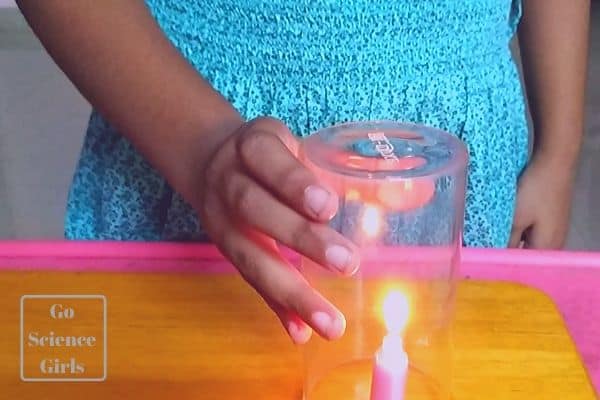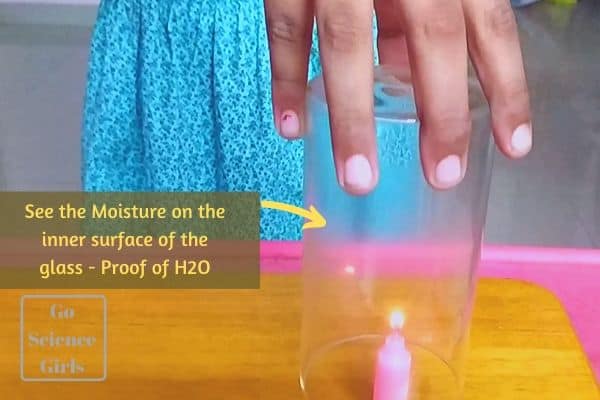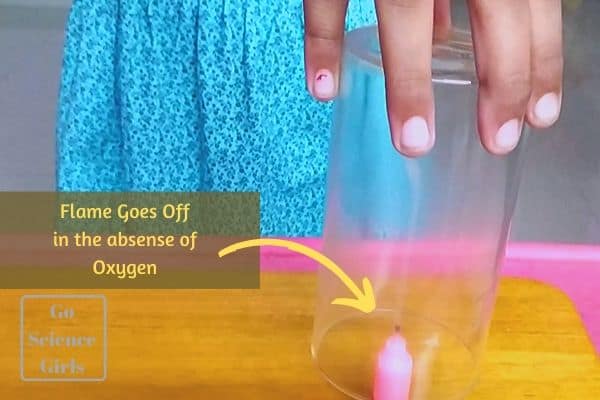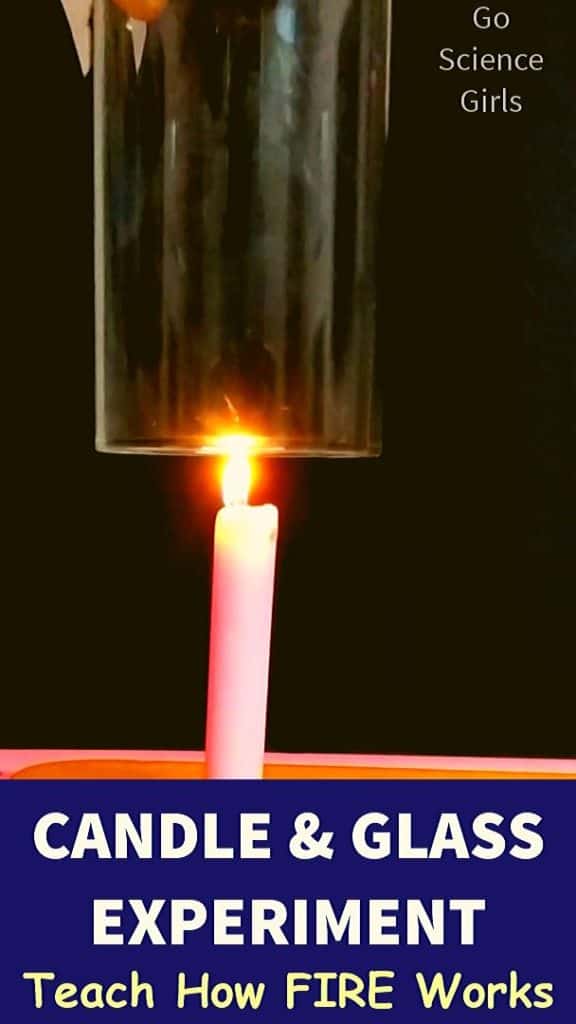We did this cool candle and glass experiment last week. The experiment teaches of role of oxygen in fire and its presence in the air. This one takes less than 5 minutes to complete it.

5 – 6-year-old kids can experiment this by noting time and they can learn how much oxygen is required to burn the candle. They can learn about smoke and wax.
8+-year-old kids can learn chemical equations, balancing them and the detailed science behind the candle and glass experiment.
How to do this candle and glass experiment
The simplest experiment to do but has a big science behind it. Don’t panic this science is easy for even kids to understand. Let us first do this experiment and study the science behind it.
Materials required for carrying out the experiment
- Candle
- Candle Lighter or Matches
- Drinking glass
- Ceramic dinner plate or wooden board (optional)
[*Product links are affiliate links. Your support is highly appreciated]
Arrangement
Place the candle on the plate. Keep the matchbox and glass tumbler ready.

Action
Light the candle and leave it for some time and then close the candle with a glass tumbler so that you can see through the light.

Result
After a few seconds, you can see the flame comes down slowly and eventually goes off. You can try opening the glass when the flame is low to see how it picks up oxygen again and the flame goes higher.
You can also see a small sediment of moisture in the inner walls of the glass. That is a proof that fire releases H2O.

Variations
Yes, the experiment is over. Now, try these and share your experience with us.
- Now you can do this using a stopwatch and check the time taken for the light to go off after closing the candle with glass.
- Use the candle of different size and check the timing.
- Also, use bigger and smaller glass to check the timing.
Do this experiment with kids and allow them to make the observations.
Therefore oxygen is required for the candle to burn for a long time.
Detailed science with terminologies
Hydrocarbons present in the wax are converted to carbon dioxide and steam and this chemical process is called combustion. The oxygen gets pulled at the bottom and the wick draws the fuel. This will provide heat at the top and that makes air hot to rise up. This is how a candle burns. The steam part gives the blue color to the fire. The unburned carbon deposit makes the walls nearby black. Better oxygen means brighter the flame. Match stick is required to ignite and that produces the activation energy to start the entire burning process.
The chemical equation for your reference
Methane (hydrocarbon) + Oxygen –> Carbon dioxide and Water
CH4 + 2 O2 –> CO2 + 2 H2O
Check scienceline for more science facts. Also, read candles.org explanation to master the science behind candle and science experiments.
FAQs
When the candle is placed in the jar it limits the flow of oxygen and hence the candle flame goes off.
Oxygen is the fuel for wax and makes the wick burn. When the candle is closed with the glass jar the oxygen supply is stopped. Initially, the candle burns by making use of the oxygen within the glass and slowly when there is no oxygen the flame goes off.
The candle that is the shortest will go out first. It is because the CO2 is denser than air so it will settle down at the bottom eventually putting off the fire.
Glass is also prone to crack and break due to heat. Check out for heat resistant glassware and use them for this experiment.
When the candle is lighted the heat of the flame will melt the wax first near the wick that is on the top. Thus the wax will melt and that liquid wax gets drawn up again by the wick due to capillary action. The flame’s heat vaporizes the wax in the liquid state and that will initiate the hydrocarbon break down process. The hydrocarbon breaks down further into molecules of carbon and hydrogen.
Combustion is the chemical reaction happening in the candle burning process. Wax is derived from petroleum and is a carbon chemical and it reacts with the oxygen present in the air. This process creates CO2 which is a colorless gas.
Yes and no. Yes if it is pure beeswax. No, if it is not a pure wax. Candles made of pure beeswax will produce no smoke and cleanses the air around. It does this by releasing negative ions in the air. Such released negative ions bind with the toxins and remove them eventually from air. Also, natural pure beeswax burns slowly, when compared to paraffin candles and hence they last for long time.
Why does a candle stop burning when covered with a glass tumbler?
Candle burning requires oxygen and that is present in the air naturally. When we close the candle with jar, then oxygen flow is limited and once all the oxygen present is exhausted the candle gets extinguished.

Overall, stay around and explain to them to have fun.
In addition, please note that Candles are AC’s enemies. Yes, teach this to kids.
AC room lacks oxygen and hence burning candles will not get oxidized completely leading to forming carbon monoxide. It is dangerous to health which leads to serious complication including death. Beware!
What inspired me to do this experiment?
Let me share my experience in how did I arrive at doing this experiment? During one summer we had a massive power failure. My little ones had never been used to such a situation ever. But this time the situation was tough and they had to spend the whole night without power. That is when I lit a candle for light while we had dinner.
As usual, my curious elder daughter asked me how does a candle burn. Why does it not require electricity as lights and fan do? How come it gives brightness as an electric bulb does. She bombarded me with questions I was like feeling glad that she thinks all these things. At the same time, my naughty little younger one as usual in her style started doing fun things. She blew the candle and sang “happy birthday”.
We finished dinner and suddenly my little one using her empty glass covered the candle. In a few minutes the candle went off. I lighted the candle and told her not to play with fire. Again in few mins when I was away she did the same job to check if the light goes off. It did go off and my elder one was puzzled to know why it happened.
Her question was when there is more air candle goes off that’s exactly what happens when we blew the candle. But here the contradiction happens and when the candle is closed it should not go off as airflow is cut. Then why it happens. I told her that there is a science behind that action.
Now, we started doing this experiment to explain the concept to the kids.
